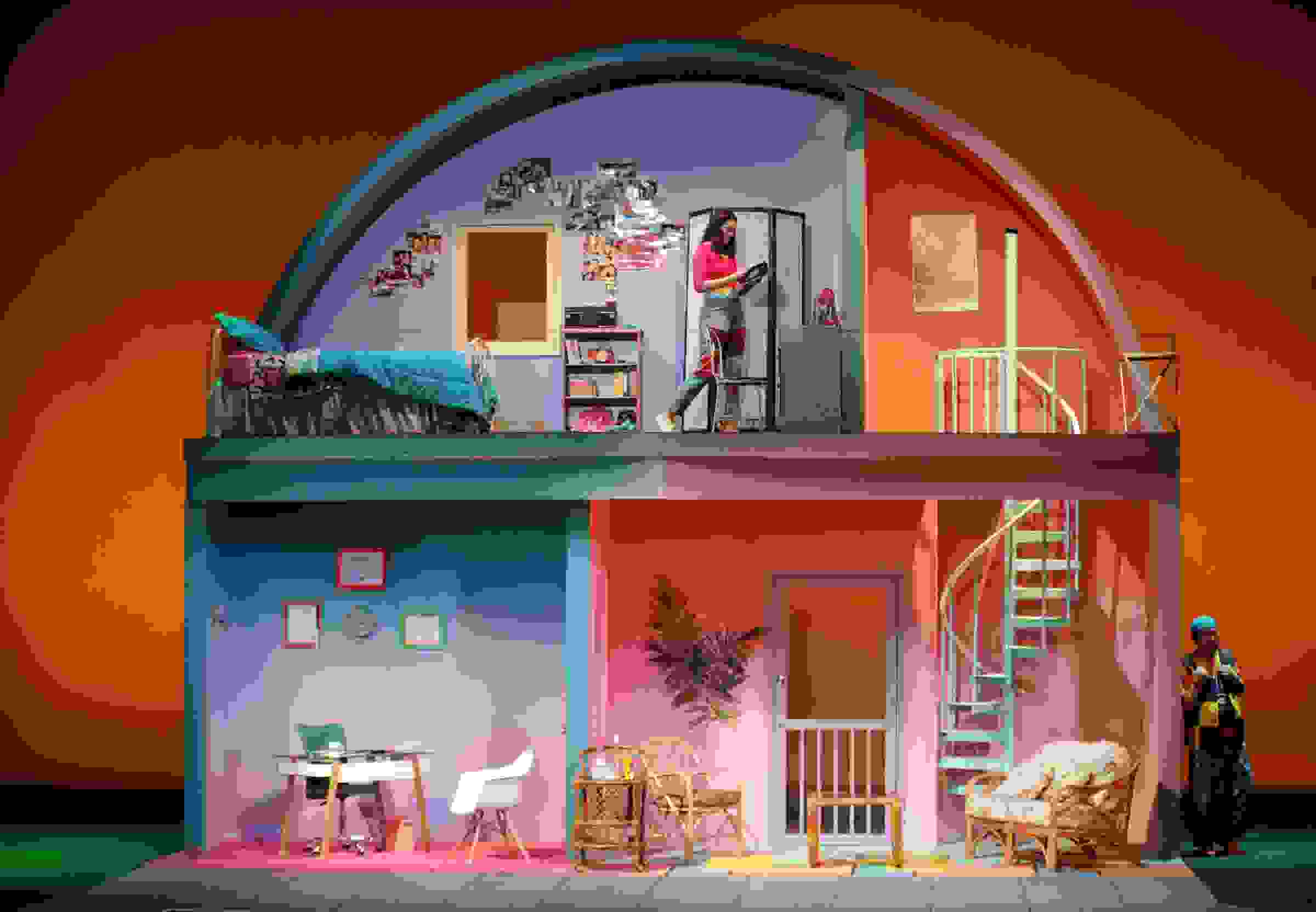Better stage lighting technology illuminates new expressive possibilities

Color theory — the association of certain colors with patterns of emotions — has recently become an area of significant scholarly research. Operatic lighting designers, however, have been intuitively using lighting to illuminate and emphasize emotional resonances for decades now. “If you’ve got a key change, it’s time to get color involved,” says Duane Schuler, a lighting specialist who has worked with the Metropolitan Opera, Lyric Opera of Chicago, and more. Schuler lit a production for LA Opera that the company revived in November 2022: “You might want reds and ambers for major keys; blues and greens and purples for minor keys. When Scarpia makes his first entrance in Tosca, in the middle of the children’s chorus, the whole mood changes.
“But you don’t want the audience to see the lighting change; you want them to feel it.”
Lighting is just one of the tools designers and directors employ to help tell a story on the operatic stage, and in the mid-2010s, lighting technology took a significant step forward with a definitive transition from tungsten-based lights to LED (light-emitting diode) lights. “We’re living in a world where we’re looking at LED lights all the time,” says lighting designer Anshuman Bhatia, adding that his job is to translate core storytelling principles into technical specifications. Bhatia was a winner of OPERA America’s Robert L.B. Tobin Director-Designer Prize in 2015. The honor came toward the start of his career, which means that he has come of professional age in the LED era. “Whether you like it or not, it’s a fact of life — and that affects how you go to the theater and look at lighting,” he says.
In addition to helping the industry shrink its carbon footprint, the shift to LED also has affected the practice of lighting in opera, changing the way designers perform their jobs and the possibilities for using light to shape a production’s aesthetics. For some productions, this has elevated the emphasis a director places on lighting as an artistic element, and today companies are continuing to experiment and forge ahead with new moving lights and other technologies.

TECHNICAL SPECS
Before the advent of LEDs, traditional incandescent lights threw out white light; designers achieved different hues through the use of color filters called “gels.” Originally, this limited each lamp to a single color. Later, “scrollers” attached to the gel frame allowed lighting crews to shift colors in the middle of a performance. By their very nature, the gels filtered out a measure of light from the tungsten-burning lamps, especially toward the darker end of the color spectrum.
Changing to LED lights, however, has “changed the way designers design,” says Gary Marder, formerly resident lighting designer at San Francisco Opera, now a freelancer. “Instead of picking colors ahead of time, you can now mix the ones you desire, live.” The strength of the light thrown by an LED, on the other hand, is in no way affected by its shade of color. It can achieve the same amount of saturation with a deep blue as with a bright yellow: a phenomenon seen during the holiday season with blue Christmas lights in malls across the country.
It’s also made controlling the lights in real time far simpler. In the old days of “piano boards” — the lighting-control boards that resembled an upright piano — designers would sometimes bring preplanned lighting schemes to their productions. Today’s rigs allow not only for a much wider range of lighting options, but for a new kind of flexibility on the part of designers. “We now can make our choices much more quickly,” says Schuler. “Ten or fifteen years ago, if somebody said, ‘The colors aren’t right in that scene and we need a new light on the soprano,’ a lighting crew would come in the next day to change the setup. Now it can be done right away. Directors and designers know you have incredible flexibility, and it has changed their expectations. Now, they might ask you to go from green to purple in a second.”
The near-improvisatory approach that LEDs foster is especially useful in opera, given its abbreviated window for technical preparation. “The biggest frustration in opera is the time element,” says Schuler, a veteran of theater as well as opera. “When people come to opera from other theater work and see their schedule, they say, ‘This is it?’ When a Broadway show runs into problems, it can delay its opening for a week. With opera, it’s going to happen when it’s supposed to happen, one way or another.”
Individually, LED lights carry a considerably higher sticker price than their incandescent counterparts, but they nonetheless tend to generate cost savings over the long haul. “It isn’t a one-to-one relationship,” says Luke Delwiche, entertainment market manager for Electronic Theatre Controls (ETC), a leading theatrical lighting manufacturer. “They use much less power, so they’re a lot cheaper to run. Tungsten lights also require a lot more infrastructure in terms of dimmer racks and individual power circuits. And if you wanted four different colors on stage in a show, you’d need four tungsten lights, but now just one LED light can do the job.”

FLASH VS. SUBSTANCE
Looking to the future, opera companies are increasingly experimenting with “moving lights” in different productions. As the name suggests, these mechanized fixtures allow lighting beams to travel across the stage. They first gained currency in rock and roll, adding to the flash and dazzle of bands’ stage shows. The first generation of moving lights, though, had a limitation that made them unsuitable for opera: they required the use of fans that generated a lot of noise. “The noise didn’t matter for the Red Hot Chili Peppers, but it did matter for Puccini,” explains Delwiche.
But in 2017, ETC came out with SolaFrame Theatre: a moving light that operates “fanless,” thus making it suitable for use in opera. “The further we get in time,” Bhatia says, “the quieter the lights get.”
Such flashy techniques, as well as the nearly unlimited range of lighting options that LED offers, can run the risk of fronting spectacle over substance. “You can think that you’re required to create bang for buck,” says Paule Constable, a British lighting designer who works in theater as well as opera. “The Lloyd Webber/Cameron Mackintosh/Disney machine gives you the sense that if you haven’t got a thousand cues and wizzy-woos, then you aren’t doing it properly.”
“You can use the flash-and-trash of rock and roll, but should you?” asks Schuler. “Sometimes it can be effective to knock the audience’s socks off, but restraint is a wonderful thing. If you distract from the story, you aren’t doing the job you’re supposed to be doing.”
Regardless, LED has brought an expansion of lighting’s storytelling capabilities even for the most simply lit productions. Gary Marder points to Jun Kaneko’s stripped-down production of Madama Butterfly, which came to San Francisco Opera in 2014. The set consisted of little more than a raised disc placed in front of a cyclorama, its spareness heightening the role of the lighting scheme. “I had to set the mood as well as tell about time and place,” Marder says. “Improvements in technology made the storytelling more possible and easier.”



CULTURAL HUES
While scholarly research is digging deeper into color theory, the findings of the academic world have tended not to filter into the work of lighting designers. They see their job as an art, not a science, depending more than anything else on their own finely honed sensitivity to the needs of the piece at hand. “I incorporate a degree of emotional color picking into my design, as most directors do, but it really is subjective,” says Marder. “In Act III of Rigoletto, you’ve got a dark night in a storm, with a murder happening. To me, that has a blue-green feel to it — as opposed to a romantic night, like in the second act of Bohème, which has a festive, warm feel.”
Lighting decisions can be culturally coded, as Marder found out in 2016 when he was working on the world premiere, at San Francisco Opera, of Bright Sheng and David Henry Hwang’s Dream of the Red Chamber. His collaborators were the Taiwanese American director Stan Lai and the Hong Kong-born production designer Tim Yip. “They wanted to use lots of red to depict a wealthy house,” Marder says. “You seldom see a red set from Western designers; Western audiences perceive red as indicating anger. It’s a cultural difference. But were we trying to adapt the story for a Western audience, or were we trying to tell a Chinese story in a Chinese way? We opted to tell it in a Chinese way.”
And when Bhatia lit a Madama Butterfly at Palm Beach Opera in January, director Alison Moritz employed vintage sets from 1967. It was Bhatia’s job to bring the look of the production culturally up to date, as sensibilities have evolved along with stage technology. “If we were to do a 1990s design, would it look tired? Absolutely!” says Bhatia. “It’d be lacking in nuance and much less cue-heavy. The idea is no longer ‘OK it’s nighttime, let’s make it blue.’ We’ve moved on. What I’ve come up with is a 2023 design — and I’m still pushing the limit.”
AN ENVIRONMENTAL LENS

Paule Constable lit Peter Grimes at Opera North in 2006.
A 2022 Department of Energy report found that even with manufacturing costs factored in, LEDs over their lifetimes offer significant savings in energy. Commonly used tungsten bulbs used up to 750 watts at full power and can reach up to 425ºF, while comparable LED lights require less than half of that energy, only about 300 watts, and reach 176ºF. This means they require less electricity and demand less of a venue’s HVAC system. LEDs also do not burn out like incandescent lights, so their effective lives are much longer.
It’s worth noting, however, that the LED manufacturing process itself — which requires far more parts than tungsten bulbs, including semiconductors — creates a greater carbon footprint since the shipping of source materials involves more airplane miles. Plus, the computer parts make LED bulbs more difficult to recycle.
Lighting designer Paule Constable, who is working with the U.K.’s Opera North to develop a climate-neutral season, warns that LED is hardly a panacea for the industry’s energy-consumption problems. For one thing, she notes, the lighting in public areas, along with administrative and backstage spaces, tends to use markedly more energy over the course of operations than stage lights do. “Even at Opera North, when they say, ‘Let’s talk about the LED rig,’ I say, ‘Can we talk about how everyone is getting to work, please?’” Constable says. “We need to be talking about sustainability more — what the creative impact will be if we walk more gently on this earth.”
This article was published in the Spring 2023 issue of Opera America Magazine.

Fred Cohn
Fred Cohn is the former editor of Opera America Magazine.






